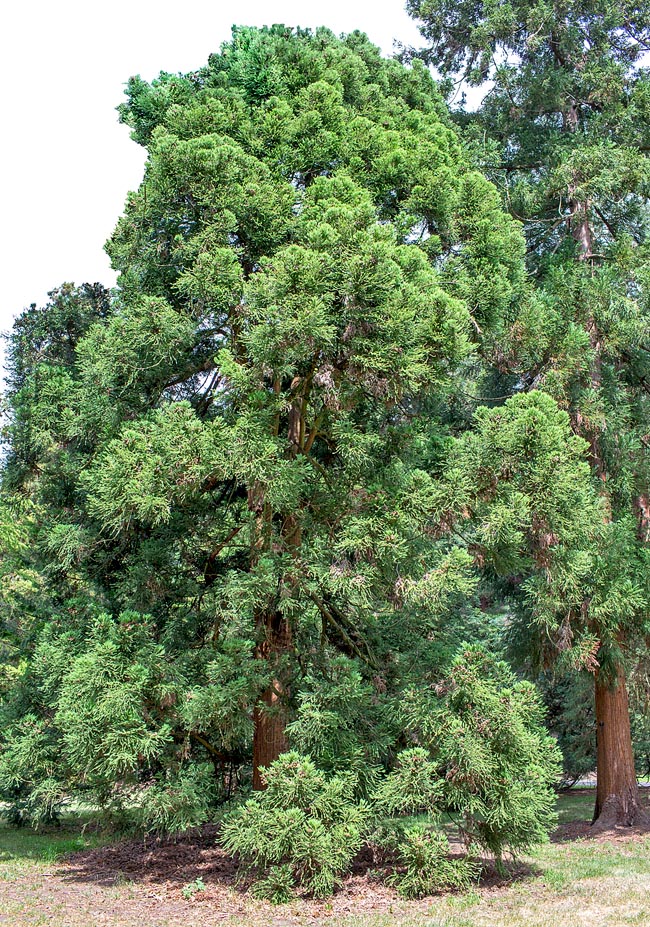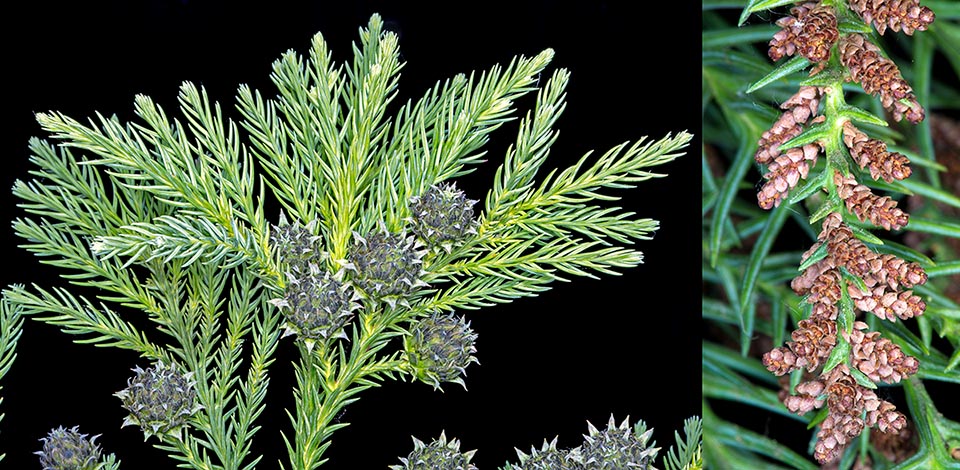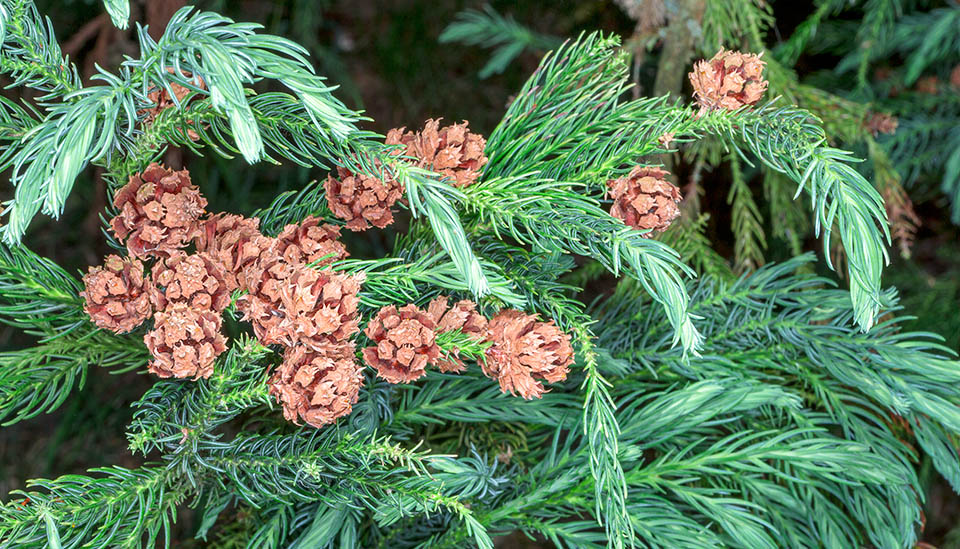Family : Cupressaceae

Text © Pietro Puccio

English translation by Mario Beltramini

The Cryptomeria japonica may be 40 m tall with a basal diameter of 2 m © Giuseppe Mazza
The species is native to central-southern Japan where is diffused in the forests between the 100 and 1800 m of altitude.
The etymology of the genus, not specified by the author, should come from the combination of the Greek adjective ““κρυπτός” (cryptós)”= hidden and of the substantive “μέρος” (méros) = part, with reference to the reproductive parts of the plant hidden by bracts; the Latin specific name refers to the origin site.
Common names: Japanese cedar (English); ri ben liǔ shan (Chinese); cédre du Japon, cryptomérias du Japon (French); sugi (Japanese); cedro rosso del Giappone, criptomeria (Italian); Sicheltanne (German).
The Cryptomeria japonica (Thunb. ex L.f.) D.Don (1839) is an evergreen monoecious tree with erect trunk, up to about 40 m tall and of 2 m of diameter at the base, with reddish brown to dark grey fibrous bark tending to flake in long longitudinal stripes.
The crown is dense, conical, columnar or ovoidal with main branches almost verticillate, more or less horizontal, and lateral branchlets usually hanging. Lesiniform leaves, more or less curved at the apex, 0,5-1,8 cm long and about 1 mm broad, spirally arranged in 5 rows, rigid, fragrant, persistent 4-5 years, of pale green colour that may turn bronze in the coldest winters to then become again green in spring.
Ovoid male cones, 2-6 mm long and of 2-4 mm of diameter, united in sessile axillar racemes close to the apices of the 2 years old lateral branchlets, of reddish colour tending yellow when ripe, formed by several microsporophylls (modified leaves bearing the microsporangia), spirally arranged, bearing 3-6 pollinic sacs. Terminal female cones, solitary or at times in groups up to 6, sessile, globose, of 1-2 cm of diameter, formed by 20-30 scales arranged in a rosette, with 2-5 ovules per bract, but in the sterile apical ones. Irregularly ellipsoidal seeds more or less compressed, 4-6 mm long and 2-3 mm broad with a tiny wing, of brown colour; the germination is epigeous.
It reproduces by seed in spring, with germination times of 1-2 months, and by semi-woody cutting in late summer.
Species amply diffused and cultivated since immemorial time in Japan, of which is the national tree, and in China, due to its beauty, the easy cultivation, the growing speed and the wood of excellent quality. Grows better in the temperate climates with warm and humid summers, bears winter lowest temperatures up to about -20 °C, requires fertile soils, deep, draining, acidic to neutral, maintained constantly humid, and an exposition preferably in full sun or at most slightly shady, does not bear the dry and salty winds. The wood, light, compact, lasting, resistant to rottenness, easy to work, is utilized in the civil and naval constructions, in particular in Japan, and for frames, furniture and in the paper industry.
They have selected numerous varieties that differ for the colour of the leaves, shape of the foliage and the height, in particular the dwarf varieties are suitable for small gardens and are also an excellent subject to cultivate in pot for the decoration of open spaces; moreover, it is a species much appreciated for bonsai.

Close-up of of growing female cones, 1-2 cm broad with 20-30 scales arranged in rosette, and on the right, of 2-6 mm long male cones © Giuseppe Mazza
Synonyms: Cupressus japonica Thunb. ex L.f. (1782); Taxodium japonicum (Thunb. ex L.f.) Brongn. (1833); Schubertia japonica (Thunb. ex L.f.) Jacques (1837); Cryptomeria nana Lindl. & Gordon (1850); Cryptomeria fortunei Hooibr. ex Billain (1853); Cryptomeria lobbiana Billain (1853); Cryptomeria japonica var. lobbii Carrière (1855); Cryptomeria japonica var. nana Carrière in H.A.Jacques & F.Hérincq (1857); Cryptomeria elegans Jacob-Makoy (1864); Cryptomeria araucarioides Henkel & W.Hochst. (1865); Cryptomeria japonica var. dacrydioides Carrière (1867); Cryptomeria japonica var. pungens Carrière (1867); Cryptomeria japonica var. sinensis Miq. in P.F.von Siebold & J.G.Zuccarini (1870); Cryptomeria japonica var. spiralis Miq. in P.F.von Siebold & J.G.Zuccarini (1870); Cryptomeria nigricans Carrière (1871); Cryptomeria lycopodioides Carrière (1874); Cryptomeria japonica var. elegans-variegata Van Geert (1875); Cryptomeria lobbii (Carrière) Lavallée (1877); Cryptomeria japonica f. araucarioides (Henkel & W.Hochst.) Beissn. (1887); Cryptomeria japonica f. compacta Beissn. (1887); Cryptomeria japonica f. elegans (Jacob-Makoy) Beissn. (1887); Cryptomeria japonica f. lobbii (Carrière) Beissn. (1887); Cryptomeria japonica f. nana (Carrière) Beissn. (1887); Cryptomeria japonica f. pungens (Carrière) Beissn. (1887); Cryptomeria compacta Beissn. (1891); Cryptomeria mucronata Beissn. (1891); Cryptomeria pungens Beissn. (1891); Cryptomeria variegata Beissn. (1891); Cryptomeria viridis Beissn. (1891); Cryptomeria generalis E.H.L.Krause in J.Sturm (1906); Cryptomeria japonica var. fortunei (Hooibr. ex Billain) A.Henry in H.J.Elwes & A.Henry (1906); Cryptomeria japonica var. compacta (Beissn.) C.K.Schneid. in E.E.Silva Tarouca (1913); Cryptomeria japonica var. pendulata Bronsart (1913); Cupressus mairei H.Lév., (1916); Cryptomeria kawaii Hayata (1917); Cryptomeria japonica var. caespitosa Makino (1928); Cryptomeria mairei (H.Lév.) Nakai (1937); Cryptomeria japonica var. radicans Nakai (1941); Cryptomeria japonica var. pendula Leroy ex Dallim. & A.B.Jacks. (1948); Cryptomeria japonica f. dacrydioides (Carrière) Rehder (1949); Cryptomeria japonica f. spiralis (Miq.) Rehder (1949); Cryptomeria japonica subsp. sinensis (Miq.) P.D.Sell (1990).

The female cones open when ripe dispersing small 4-6 mm ellipsoid seeds having a tiny wing that facilitates their dispersion © Giuseppe Mazza
→ To appreciate the biodiversity within the CUPRESSACEAE family please click here.
